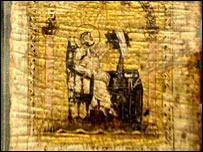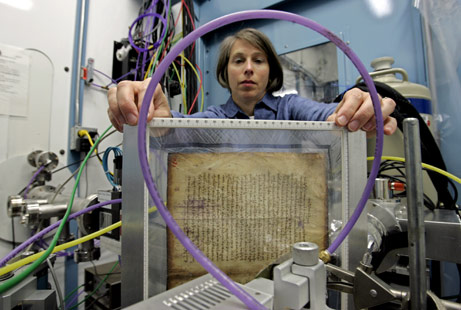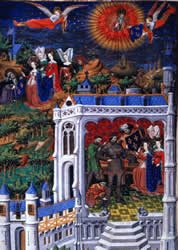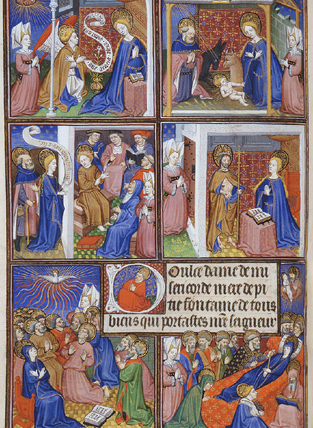Posts from — April 2007
Medieval Scribe, John Myronas, a 13th Century Parchment Recycler
 Yet another layer of history has been discovered in a Christian prayer book attributed to John Myronas. The most recent discovery is the third layer of text discovered in this recycled 13th century manuscript. In 2002, modern multi-sectional and multi-spectral imaging methods discovered greek writings from the 4th century. An article in the National Geographic News describes the earlier find:
Yet another layer of history has been discovered in a Christian prayer book attributed to John Myronas. The most recent discovery is the third layer of text discovered in this recycled 13th century manuscript. In 2002, modern multi-sectional and multi-spectral imaging methods discovered greek writings from the 4th century. An article in the National Geographic News describes the earlier find:
In 2002 researchers had uncovered writings by the mathematician Archimedes and the fourth-century B.C. politician Hyperides.
Last year one of the pages was found to contain a famous work by Archimedes about buoyancy that had previously been known only from an incomplete Latin translation.
A third layer has been been revealed and the details were presented today at the meeting of the American Philosophical Society by Reviel Netz and Roger Easton. From the BBC:
A series of clues, such as spotting a key name in the margin, led the team to its conclusion.
“The philosophical passage in the Archimedes Palimpsest is now definitely identified as a relatively early commentary to Aristotle’s Categories,” said Professor Netz.
He said that Aristotle’s Categories had served as the foundation for the study of logic throughout western history.
Further study has revealed the most likely author of this unique commentary is Alexander of Aphrodisias, Professor Robert Sharples from the University College London told BBC News.
If this is the case, he said, “it gives us part of a commentary previously supposed lost by the most important of those ancient commentators on Aristotle”.
From the National Geographic News:
n the 10th century a scribe had copied the ancient Greek manuscripts from papyrus scrolls onto parchment—thin leaves of treated animal skin.
Later the writing was washed out using a solvent such as orange juice and overwritten with new text—a process known as palimpsesting.
“In those days, parchment writing materials were so valuable that they were commonly reused when the book was considered out of date or if the subject was judged inappropriate or less valuable,” Roger L. Easton, of the Rochester Institute of Technology, wrote in an email.
By the 12th century, pages from five different earlier works had been erased, overwritten, and compiled into a Christian prayer book, the Euchologion—what is now called the Archimedes Palimpsest.

As always, books are multi-layered treasures. I wonder what else might be discovered in this 13th century prayer book?
[tags]Euchologion, Archimedes Palimpsest, Aristotle, Christian Prayer Book, 13th century, John Myronas, Philisophical Society, Archimedes, parchment, illuminated manscript[/tags]
April 26, 2007 Comments Off on Medieval Scribe, John Myronas, a 13th Century Parchment Recycler
The Bedford and Sobieski Books of Hours Now on Display at the British Library
 The Bedford Book of Hours is going to be on display at the British Library next week. This is one of the most magnificent illuminated manuscripts in the world. It dates from the early 15th century and every single page in the over 500 hundred page book of hours is illustrated. The illustrations and illuminations are vivid and lush. On display with the Bedford Hours is the Sobieski Hours. It is also from the early 15 century. Both illuminated masterpieces are credited to an artist known as the “Bedford Master.” From the 24 hour museum:
The Bedford Book of Hours is going to be on display at the British Library next week. This is one of the most magnificent illuminated manuscripts in the world. It dates from the early 15th century and every single page in the over 500 hundred page book of hours is illustrated. The illustrations and illuminations are vivid and lush. On display with the Bedford Hours is the Sobieski Hours. It is also from the early 15 century. Both illuminated masterpieces are credited to an artist known as the “Bedford Master.” From the 24 hour museum:
The British Library is displaying two masterpieces of medieval art together for the first time in an exhibition celebrating the 15th century artist, the ‘Bedford Master’, and the collections of the manuscript owners.
Running until July 2 2007, The Bedford Hours: Owners and Illuminators, brings the Bedford Hours and the Sobieski Hours together, both lavishly illustrated medieval manuscripts by the Bedford Master (so called in honour of his noble patron the Duke of Bedford).
The 24 hour museum continues:
The identity of the Bedford Master remains uncertain, despite his having been among the leading and most prolific painters of his day. Some scholars tentatively identify him as the Alsatian artist Haincelin of Hagenau, recorded in Paris as a court painter to the Dauphin Louis de Guyenne.
This may very well be a once in a lifetime opportunity to see the very best examples of Gothic Parisian illumination. These books are the pinnacle of Gothic calligraphic art.

[tags]illuminated manuscripts, book of hours, bedford hours, sobieski hours, gothic alphabet, gothic calligraphy, british library[/tags]
April 16, 2007 Comments Off on The Bedford and Sobieski Books of Hours Now on Display at the British Library

